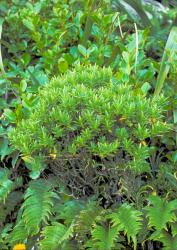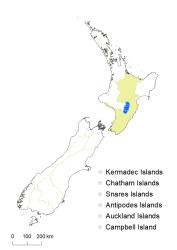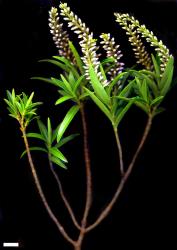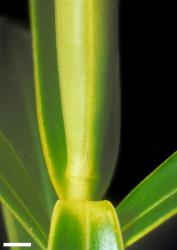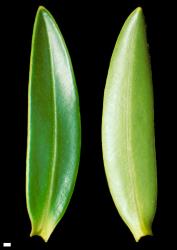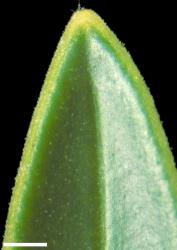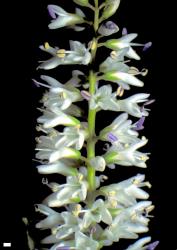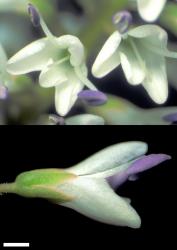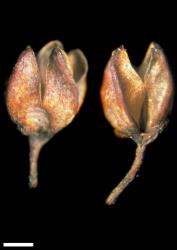- ≡ Hebe truncatula (Colenso) L.B.Moore in Allan, Fl. New Zealand 1, 912 (1961)
Bushy shrub to 2 m tall. Stems erect, eglandular-puberulent to pubescent; hairs bifarious or uniform. Leaf bud distinct, its leaves appressed at margins until fully grown; sinus absent. Leaves opposite-decussate, erecto-patent; lamina coriaceous, linear-lanceolate to narrowly elliptic, 13–42 mm long, 3.7–10.3 mm wide, glossy, dark green above, paler beneath; midrib evident; surfaces with eglandular hairs along midrib above; margin ciliolate or ciliate, entire; apex acute and plicate-apiculate with minutely truncate tip; base cuneate; petiole indistinct, broadly winged, 1–3 mm long. Inflorescence a lateral raceme, 30–90 mm long; flowers crowded, 28–68 per inflorescence, female or bisexual on separate plants, ⚥ ≥ ♀; bracts alternate or loosely whorled, linear, oblanceolate, elliptic or deltoid, usually ≤, sometimes > pedicels; pedicels erecto-patent to spreading, 0.9–2.0 mm long, eglandular-hairy all around. Calyx lobes 4, acute, or sometimes obtuse or acuminate, 1.8–2.2 mm long, sub-equal, mixed glandular- and eglandular-ciliate or -ciliolate. Corolla 5–7 mm diameter; tube white, 1.5–3.2 mm long, ≥ calyx, eglandular-hairy inside; lobes 4, white or tinged purplish at anthesis, sub-erect to spreading, sub-equal, elliptic to ovate or oblong, 2.5–4.0 mm long, obtuse; nectar guides absent. Stamen filaments white, 4.5–5.5 mm long; anthers purple. Style glabrous, 5–7 mm long. Capsules latiseptate, obtuse to truncate or sub-acute, glabrous, 3–4 mm long, 2–3 mm at widest point. Seeds ellipsoid to broadly ellipsoid, flattened, smooth, pale brown, 1.0–1.4 mm long.
V. evenosa plants, found in the Tararua Range, are similar in having glossy leaves with ciliolate margins, but they have shorter leaves and shorter inflorescences with fewer (15–40) flowers.
All other similar species are found in the South Island.
V. subalpina plants are most similar to V. truncatula plants, but they differ in their glabrous leaf margins, less prominent plicate-apiculate apex, shorter inflorescences with fewer (4–32) flowers, and longer corolla tubes.
V. rakaiensis plants have similar hairy leaf margins and plicate-apiculate apices, but they differ in their broader leaves, some lobes in each calyx rounded at the apex, ciliate corolla lobes, and hairy capsules and styles.
V. calcicola plants have similar glossy leaves with hairy margins, but their ovaries and capsules are hairy, and their corolla tubes are shorter than the calyces.
V. truncatula plants also differ from all the above similar species in a tendency for the flowers to be loosely whorled, which is more often a feature of species characterised by larger leaves and smaller flowers, such as V. stricta.
North Island: Volcanic Plateau (Reporoa Bog), southern North Island (Ruahine Range only, southwards to Maharahara).
Sub-alpine scrub. Recorded elevations range from 1035 to 1500 m.
Flowers: November–March; fruits: April–May (probably earlier, and persisting later).
2n = 80 (see Bayly & Kellow 2006, as Hebe truncatula).
Veronica truncatula is classified in V. subg. Pseudoveronica sect. Hebe and the informal group “Occlusae” (Albach & Meudt 2010; Bayly & Kellow 2006).
Bayly & Kellow (2006) discussed the rationale for continuing to treat V. truncatula as a separate species from the similar V. subalpina, which includes several morphological differences, flavonoid differences, and a different chromosome number, combined with allopatric distributions.
DNA sequence data so far have not demonstrated any close relationship between V. subalpina and V. truncatula; it is possible that V. truncatula has hybridisation in its history, which might obscure such a relationship, but for now DNA and flavonoid data (Bayly & Kellow (2006)) seem to argue against combining the two under one species name.



